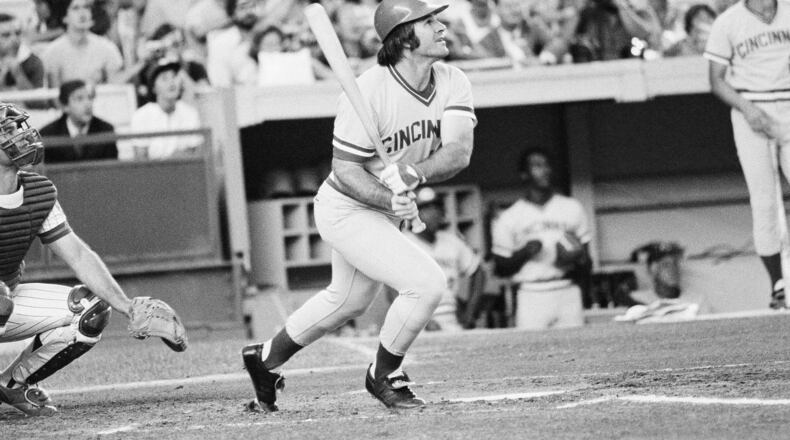Q: From the time you began writing baseball, what is the most amazing feat you have witnessed? — JASON, Beavercreek.
A: In 51 years, oh so many. And watching a writer win a bet by eating 10-foot-long Dodger Dogs doesn’t count, right? Tom Browning’s perfect game. Pete Rose’s 4,192nd hit. Two no-hitters by Homer Bailey, who was 1-14 in 2018 (that is amazing). The topper, though, was chronicling Pete Rose’s 44-game hitting streak. And I was amazed when Atlanta’s Gene Garber struck him out to end it and Rose complained by saying, “The guy pitched me like it was the seventh game of the World Series.” So, Pete, did you expect him to throw you a meatball right down the middle?
Q: What is your opinion of the ghost runner for extra-inning games? — DALE, Greenup, KY.
A: Of all the recently implemented new rules, this is the one I dislike the most. Putting a free runner on base is un-baseball. The runner doesn’t deserve to be there, didn’t earn it. And if it’s so good for the game, why do they do away with it for the postseason? I rest my case and I didn’t need an attorney.
Q: When a Reds player hits a home run, they no longer put on the Viking helmet and robe, but they run down into the tunnel behind the dugout and what’s that about? — HARRY, Kettering.
A: I’m glad most teams have stopped the choreographed juvenile dress-up so-called celebrations. The Reds run down the steps to the tunnel to whoop it up in private. When a team is under .500, celebrating home runs amongst themselves is probably a good thing.
Q: If you were made Reds’ general manager this off-season with a similar budget, what moves do you make to improve the team? — JUSTIN, Las Vegas.
A: I have a better chance of being the Japanese emperor than being Reds GM. Theoretically, though, the Reds have no real power hitter while playing in GABP Homer Haven. Doesn’t matter if he is right-handed, left-handed or ambidextrous, I go searching for a guy who can hit 40 or more home runs. Unfortunately, those guys don’t wander the streets looking for a job. So, I’d settle for a guy who can hit 30.
Q: With interleague play, do you miss teams just playing teams in their own league? — TIM, Xenia.
A: I’m so old school I miss hula hoops, mood rings and Chia pets. I despise interleague play. Fans say it gives them a chance to see players in both leagues. Isn’t that why they invented television? I miss and prefer seeing a World Series between two teams that haven’t played each other six or seven times during the season. There is a mystique about that.
Q: What are some of the funniest stories from your days covering the Reds? – LAURA, Chattanooga.
A: Relief pitcher Rob Murphy wearing his girlfriend’s black bikini panties under his uniform for good luck? Dave Concepcion climbing into an industrial drier to end a slump and Pat Zachary turning it on, scorching off most of Concepcion’s body hair? Jose Rijo refusing ice for his arm and rubbing snake oil on it instead? Bret Boone walking around the clubhouse stark naked except for the cowboy boots he pilfered from Jeff Brantley’s locker. Tom Browning, in full uniform, sitting atop an apartment building across the street from Wrigley Field during a game? Tom Seaver snipping off a writer’s tie at the knot and handing the cut off piece to the cursing writer? As Jimmy Durante used to say, “I got a million of ‘em.”
Q: What’s the deal with catchers setting up and catching with one knee on the ground? — TOM, Cincinnati.
A: That’s a head-scratcher to me because it limits their ability to scramble and block balls in the dirt and it must be difficult to make throws to second base. The theory is that it makes it easier for them to frame pitches and steal strikes. So what? Isn’t stopping wild pitches and stolen bases more important than trying to fool the umpire, which doesn’t happen that often?
Q: You have seen great baseball throughout your career and what decade was the best? — SCOTT, Syracuse, NY.
A: This is a selfish answer. Readership is better when a team wins. So, for me the 1970s and The Big Red Machine was, by far, the best decade. The Reds won the World Series in 1975 and 1976. And they were in the World Series in 1970 and 1972. That was the beginning of my baseball-writing career, and I thought, “Hey, this is the way it will always be.” Then came the 1980s and Cincinnati’s 101-loss season in 1982 and I discovered the other end of the spectrum. It was a lonely time.
About the Author

